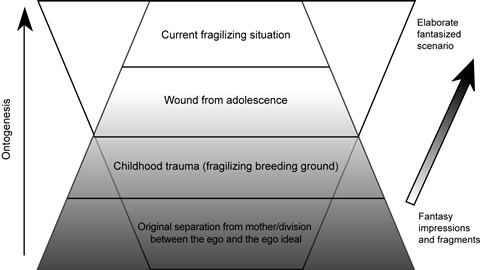Passion and Fantasy: Why do we Fall in Love?
(Please refer to the French version for the complete article)
Katia Fournier M.A.
In its narrowest definition, passionate love can be summarized as suffering caused by infatuation. For the clinical observer, it is similar to a syndrome whose signs are an affective hypertrophy combined with derealization and an alteration in judgement regarding the love object who is, at that moment, the designated source and centre of all satisfaction.
The common view in psychoanalytical writings is that passionate love originates from separation – the original separation from the mother or a separation of an intrapsychic nature between the ego and the ego ideal – and that its particular function, amongst others, is to repair the loss that ensues. But why do we fall in love at one moment in time and not another? It appears that we fall in love when we unconsciously foresee the possibility of healing a wound from the past. Through three case vignettes, this article demonstrates how the state of being love is a response to painful experiences that took place during one’s development (sexual and non sexual) and to fantasies that were created concomitantly. This article also demonstrates how the combined reparative powers of the state of being in love and erotic imagery create a synergic force that assures victory over past wounds.
The hypotheses presented in this article are based on three case studies: Philippe, Louis and Marguerite. Figure 1 illustrates the wound-fantasy dialectic that comes into play in enamouration. As we investigate the subjects’ ontogenic development, we find that the recent factor predisposing them to enamouration is related to a current life situation that makes them more vulnerable and, at the same time, opens a wound left from adolescence. In turn, this wound lies on a deeper layer, that is to say a childhood trauma that acts as a fragilizing breeding ground upon which personality, gender and sexuality develop. Assuming that, as argued by many psychoanalysts since Freud, the predisposing primary layer to all enamouration is the original separation, this fragilizing breeding ground would act as the starting point of the unique path that will take the subject’s love and sex life. Parallel to each of these layers, fantasies are developed which serve to heal the corresponding wound. At first, these fantasies are made up of impressions and fragments. As time goes by, their content becomes more and more elaborate.

Let us take Philippe who has fallen passionately in love with a 16-year-old young woman during a period in his life when he is suffering from his spouse’s emotional and physical withdrawal. This young woman has brought to the surface feelings of sexual failure he first experienced at 18 years of age after his girlfriend at the time left him because he was unable to bring her to orgasm. The elements of his past wound as well as those from his present love situation can be found in his core fantasy. In his masturbatory scenario, Philippe succeeds in giving a lot of sexual pleasure to a girl aged between 16 and 20 years old. The fact that he imagines this girl to be fragile and inexperienced is a key element in that it increases his sense of victory over the failure he experienced with his girlfriend at age 18.
Meanwhile, Louis has fallen for a colleague at work during a period when he is suffering from health problems that undermine his powers of seduction and consequently bring back feelings of rejection he experienced as an adolescent. During high school, he was very hurt by the fact that boys he was attracted to called him a “faggot”. As in Philippe, the elements of Louis’s love situation and those of his past wound are found in his core fantasy in which he imagines bringing an inaccessible man (he is either heterosexual or an employee) to orgasm. The feeling of reparation stems from, among other things, the fact that instead of being rejected, he succeeds in bringing the man to share his homosexual desires.
As for Marguerite, she’s fallen in love with a man she perceives as a Don Juan-type during a period when she feels lonely, thirsts for the absolute and wishes to find a man who will want to have children with her, all the while facing her deepest fears: to be abandoned and humiliated again if the man she loves leaves for another. In her case, the wound she dreads and is seeking to heal was caused by a broken heart she suffered at 16 years of age that brought her to attempt suicide after she found out that the one who abandoned her was seeing another girl. In her fantasy, she is penetrated by a man who is crazy about her and whose desire for her is so strong that he could never abandon her. Falling in love with a Don Juan-type gives her the impression that her victory is even greater because as she is being chosen amongst all other women, she fosters the illusion that she is the one who puts an end to this seducer’s endless pursuit of women.
Through a detailed examination of each case’s history, the article demonstrates how sexual fantasy and the state of being in love are combined to give the illusion that the wound is healed: phallic impotency in Philippe, rejection in Louis, abandonment and betrayal in Marguerite. By referring to sexoanalytical (Crépault), psychoanalytical (David) and literary (Barthes, Kundera) writings, the article also addresses the importance of “small details” in the eroticization and enamouration processes, as well as the defensive and completive functions of the state of being in love. Finally, the article attempts to explain why passion and eroticism are more stimulated by conflict, anguish and crisis than by comfort and harmony.